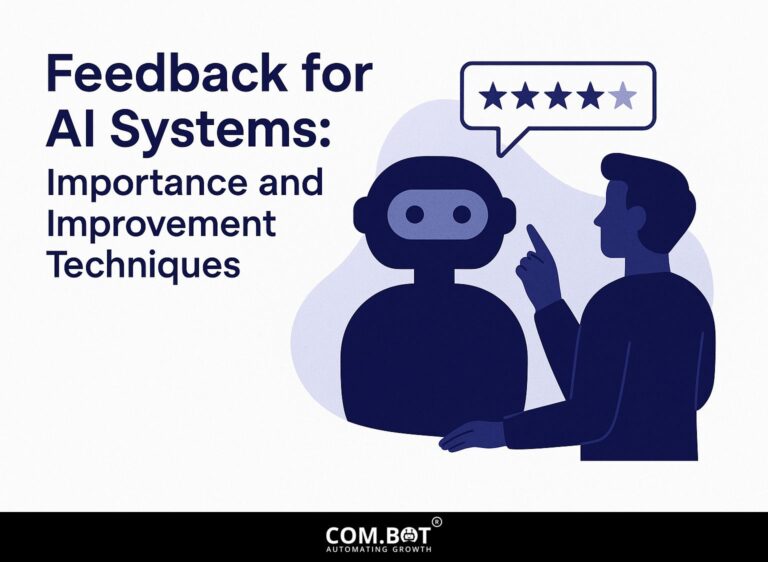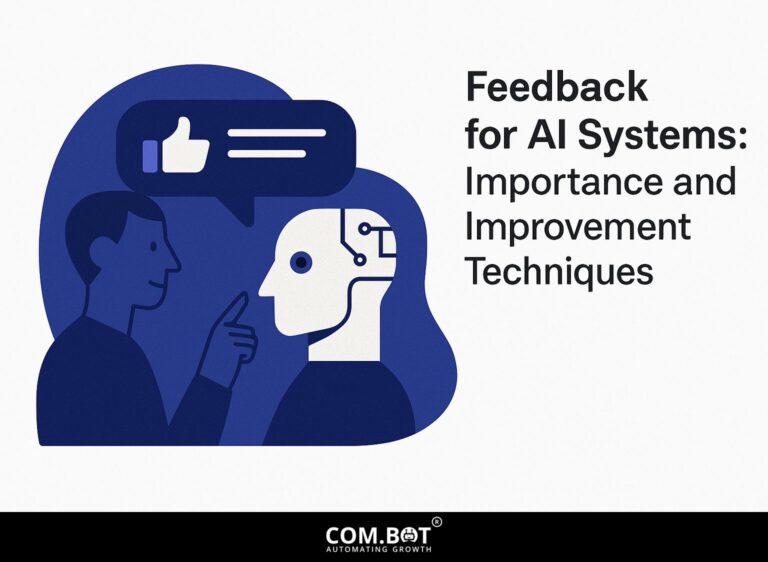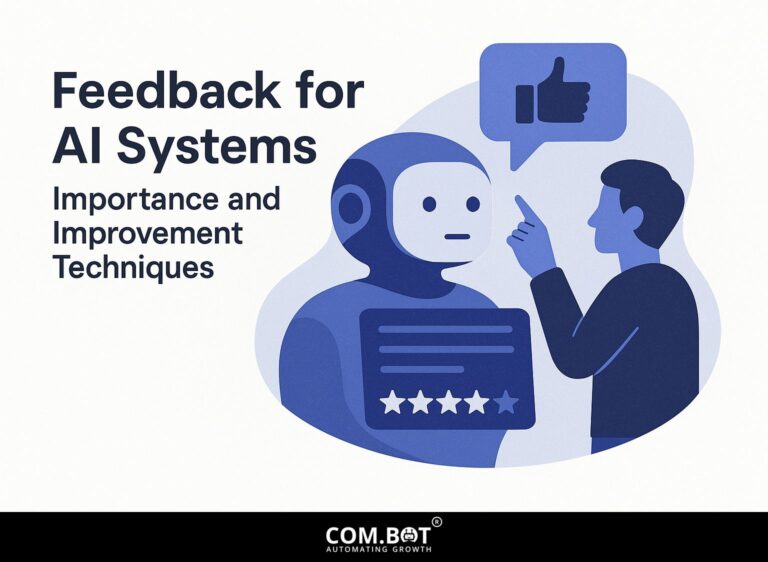Feedback for AI Systems: Importance and Improvement Techniques
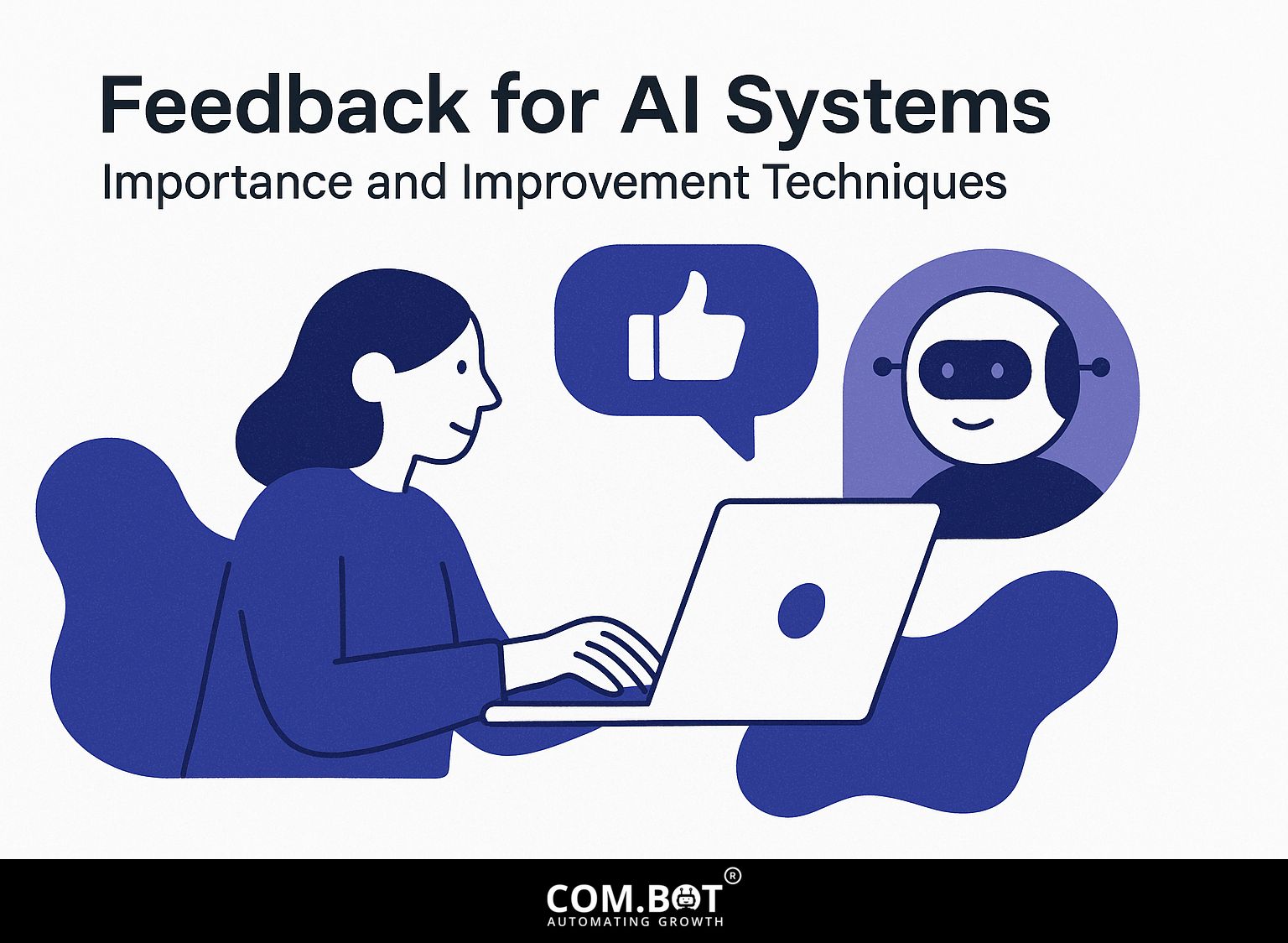
In the fast-changing area of artificial intelligence, giving useful feedback to AI systems is essential for improving how well they work. Using monitoring systems and setting up a strong feedback process can help machine learning models become more accurate and dependable. This article will discuss the importance of feedback in AI, different types of feedback systems, and methods for using user input to improve AI performance. Find out how these strategies can change how smart systems operate in the coming years.
Key Takeaways:
- 1 AI Feedback Mechanisms Statistics
- 2 Importance of Feedback for AI Performance
- 3 Types of Feedback in AI Systems
- 4 Techniques for Collecting Feedback
- 5 Improving AI Systems through Feedback
- 6 Challenges in Implementing Feedback Loops
- 7 Future Directions for Feedback in AI
- 8 Frequently Asked Questions
- 8.1 What is the importance of feedback for AI systems?
- 8.2 How does feedback contribute to the improvement of AI systems?
- 8.3 What are some common techniques used to gather feedback for AI systems?
- 8.4 Why is it important to have a diverse range of feedback for AI systems?
- 8.5 How can AI systems use feedback to address ethical concerns?
- 8.6 How can businesses use feedback to improve their AI systems?
Definition and Purpose
Feedback in AI is information gathered from users’ interactions with the system, which helps make AI models better.
This repeated process helps improve accuracy and keeps users satisfied. For instance, when users correct mistakes made by the AI, these corrections can be logged and analyzed to identify patterns of errors.
Tools like Google Analytics or custom dashboards can clearly display this data, making it easier to spot specific issues. Using user surveys or feedback forms can collect helpful information. When this information is reviewed, it can guide improvements to the model, resulting in a more efficient AI system.
Overview of AI Feedback Mechanisms
AI systems use different feedback methods, like tracking in real-time, collecting user comments, and measuring performance, to improve how they work.
Real-time monitoring tools like Prometheus can track an AI’s performance continuously, identifying issues as they occur.
By using surveys or interactive questions, developers can gather detailed user information to make algorithms better.
You can check performance metrics by using tools like Label Studio to arrange and analyze training data quickly.
These methods improve how well the operation works and help AI systems better meet what users need. If you’re interested, you can read more about the importance and techniques of feedback for AI systems.
AI Feedback Mechanisms Statistics
AI Feedback Mechanisms Statistics
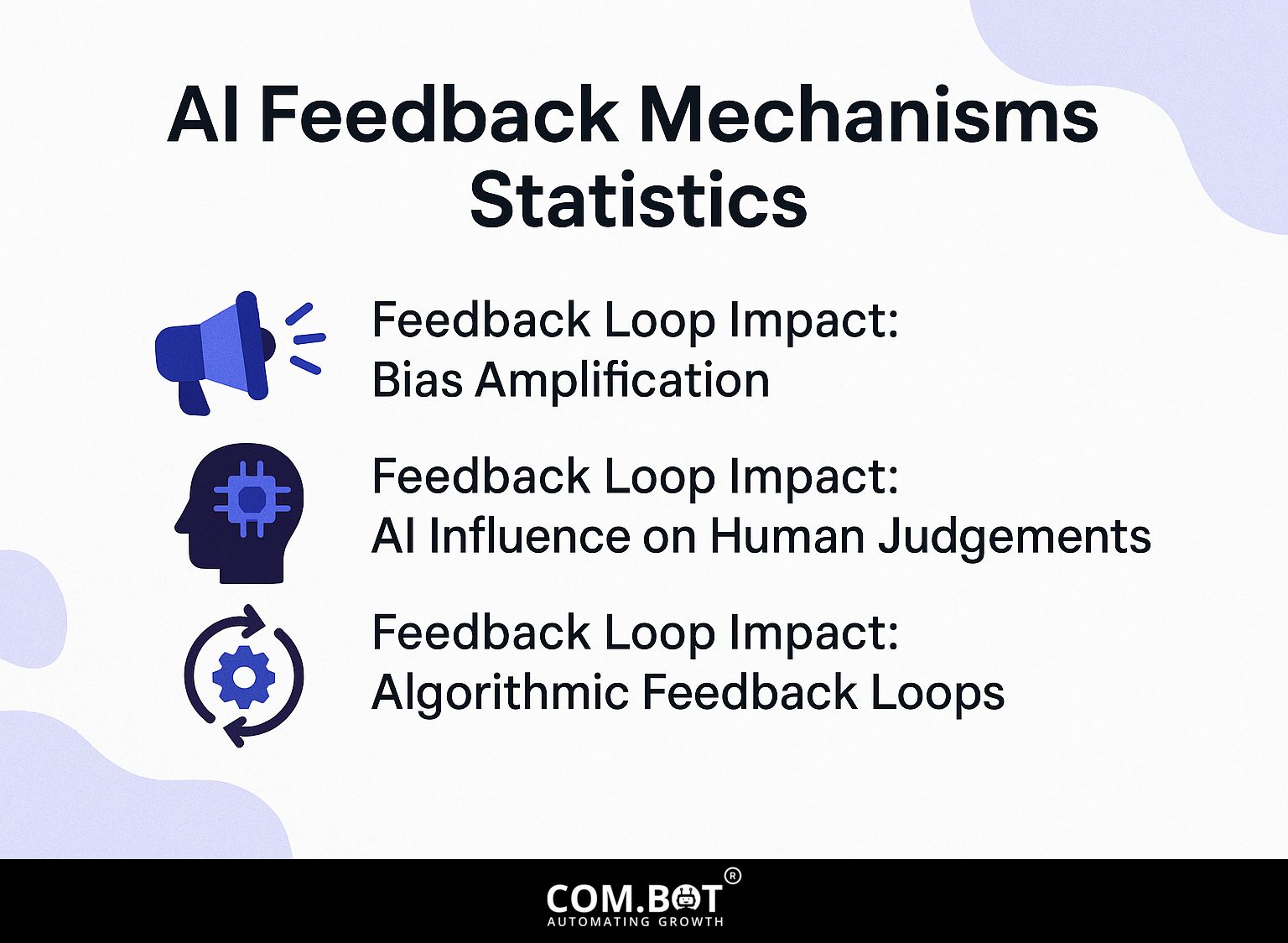
Feedback Loop Impact: Bias Amplification
Feedback Loop Impact: AI Influence on Human Judgements
Feedback Loop Impact: Algorithmic Feedback Loops
The AI Feedback Mechanisms Statistics provides information on how AI systems affect feedback loops, bias, and human decisions. This data clearly shows how AI can increase biases and affect user decisions in different situations.
Feedback Loop Impact examines several critical areas. In terms of Bias Amplification, the statistics reveal that 32.72% of participant bias is amplified by AI. This means that AI systems, when introduced, can increase the degree of pre-existing human biases. Furthermore, Emotion Aggregation Bias by AI stands at a striking 65.33%, indicating that AI significantly influences the emotional tone perceived by users. This is particularly concerning given the high initial human bias in emotion-related tasks, which is already at 53.08%. These figures show that AI systems should be thoughtfully created and checked to reduce their tendency to increase existing biases.
When looking at AI Influence on Human Judgements, the data shows that 38.2% of users chose white men after exposure to AI recommendations, compared to a baseline of 32.36% pre-exposure. This increase highlights how AI can subtly nudge human decisions, reinforcing certain stereotypes or preferences.
Regarding Algorithmic Feedback Loops, the statistics indicate a 5.03% increase in bias induced by biased algorithms. This feedback loop can perpetuate and even exacerbate biases within the system, creating a cycle that is difficult to break. However, exact algorithms improve accuracy only by 3.55%, suggesting that while positive impacts are present, they are less pronounced compared to the negative amplification of biases.
In summary, the AI Feedback Mechanisms Statistics Research shows how AI can strongly influence biases and human decisions. It highlights the importance of regularly checking and updating AI systems to make sure they support fairness and accuracy, instead of continuing or worsening existing biases.
Importance of Feedback for AI Performance
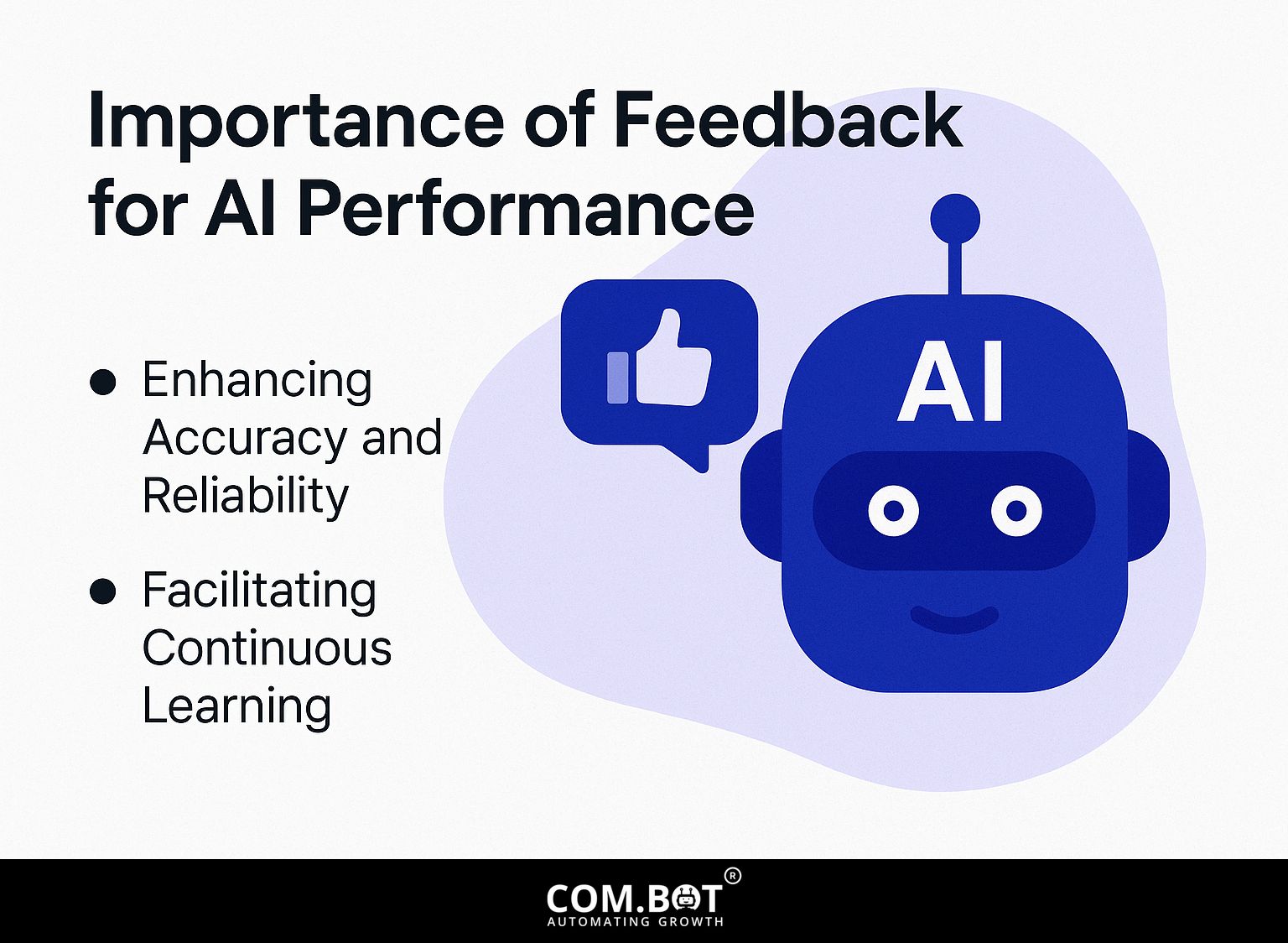
Feedback is important for improving AI performance, influencing the accuracy and reliability of machine learning models. This approach aligns with the principles outlined in our analysis of feedback for AI systems and their improvement techniques.
Enhancing Accuracy and Reliability
Examples from real life show that using what users say can make AI systems up to 40% more correct, making them much more trustworthy.
E-commerce websites such as Amazon use customer feedback to improve their suggestion systems. By analyzing customer ratings and feedback, they adjust product suggestions to better match user preferences.
Tools like Google Analytics can track user interactions, revealing which products receive the most engagement. Implementing feedback loops involves regularly updating your AI models with new data, thus ensuring they evolve with changing customer behaviors.
For example, by using machine learning tools like TensorFlow, developers can use recent user feedback to retrain their models, improving upcoming recommendations.
Facilitating Continuous Learning
AI systems that use ongoing feedback can change their learning methods, resulting in a 30% faster learning speed compared to older approaches.
This improvement stems from reinforcement learning (RL), where models receive feedback on their performance and adjust accordingly.
For example, an AI training to play chess might initially make random moves; as it plays more games, it learns which strategies yield better results.
Tools like OpenAI Gym provide environments for simulating these scenarios. User interactions, like ratings or performance metrics, help the algorithm update. This keeps it useful and effective, improving user experience.
Types of Feedback in AI Systems
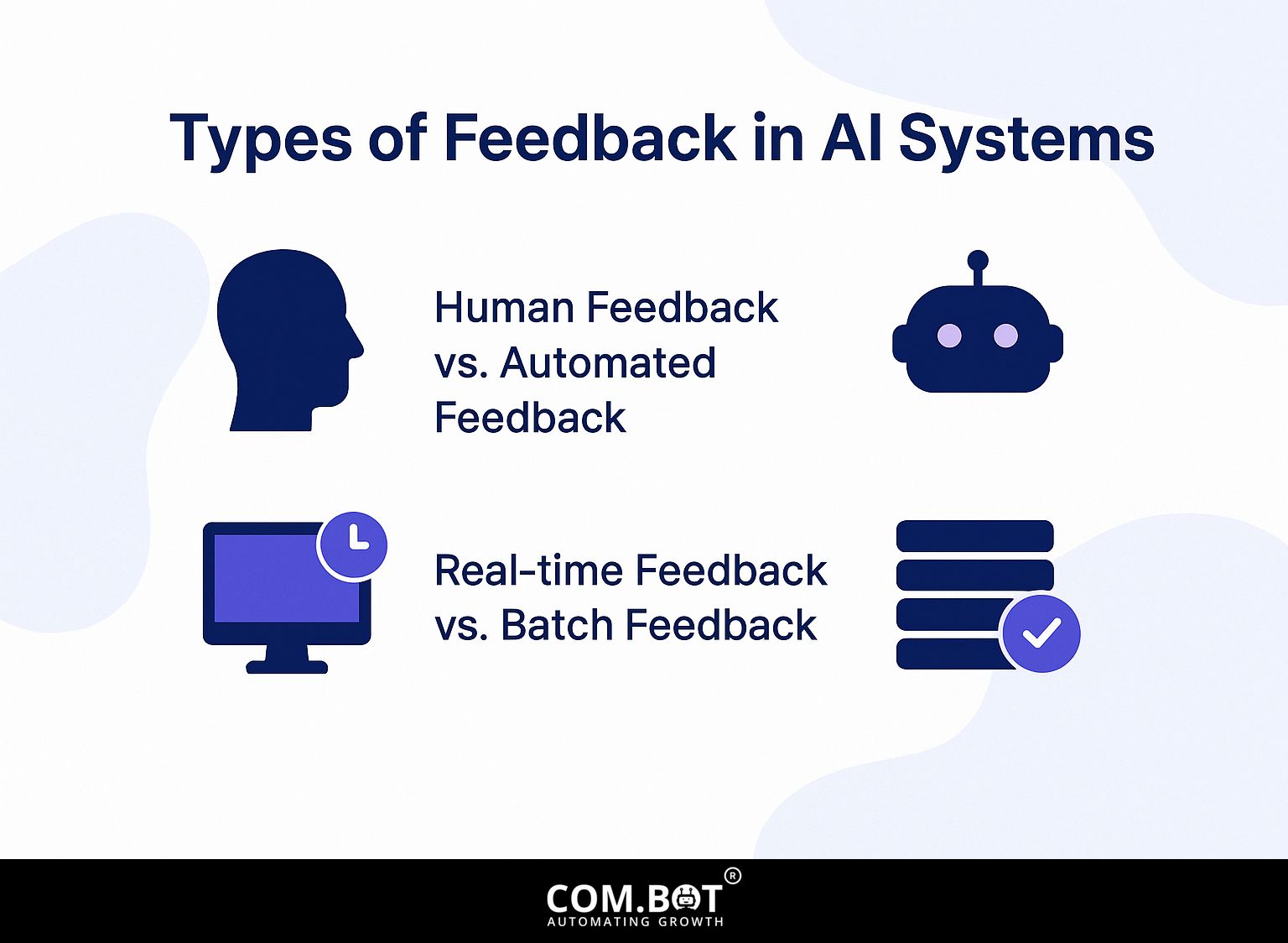
AI systems use different kinds of feedback. Each type helps improve how the model works and makes the user experience better. (For a deeper dive into these mechanisms, check out our guide on feedback improvement techniques.)
Human Feedback vs. Automated Feedback
Comments from people often provide helpful information that complements feedback from systems that automatically gather performance data in numbers.
For example, user surveys provide helpful personal feedback on product features or customer satisfaction, using tools like SurveyMonkey or Typeform.
Unlike manual methods, tools like Google Analytics observe user behavior on a website. They record the number of pages visited, the time spent on the site, and how quickly users leave, giving a broader view of the site’s performance.
By applying both methods, businesses can make products better more quickly. For instance, surveys can explain why users stop using a feature, and analytics can identify the exact location where this occurs. This combined method makes it easier to collect feedback, which supports making better decisions and enhances user interactions with the system.
Real-time Feedback vs. Batch Feedback
Getting feedback instantly allows us to modify AI processes on the spot, while gathering feedback in groups provides information over time, helping to plan ahead.
Real-time feedback systems, like predictive monitoring tools, enable organizations to make instantaneous decisions.
For instance, using software like Google Analytics in real time can reveal user behavior patterns, allowing for on-the-fly modifications in campaigns. In contrast, batch feedback from monthly reports may indicate broader trends but lacks immediacy.
Companies using both methods can improve operations. Real-time feedback helps with quick responses, while batch feedback helps develop long-term strategies by finding ongoing trends.
Balancing both approaches often leads to more effective AI implementations.
Techniques for Collecting Feedback
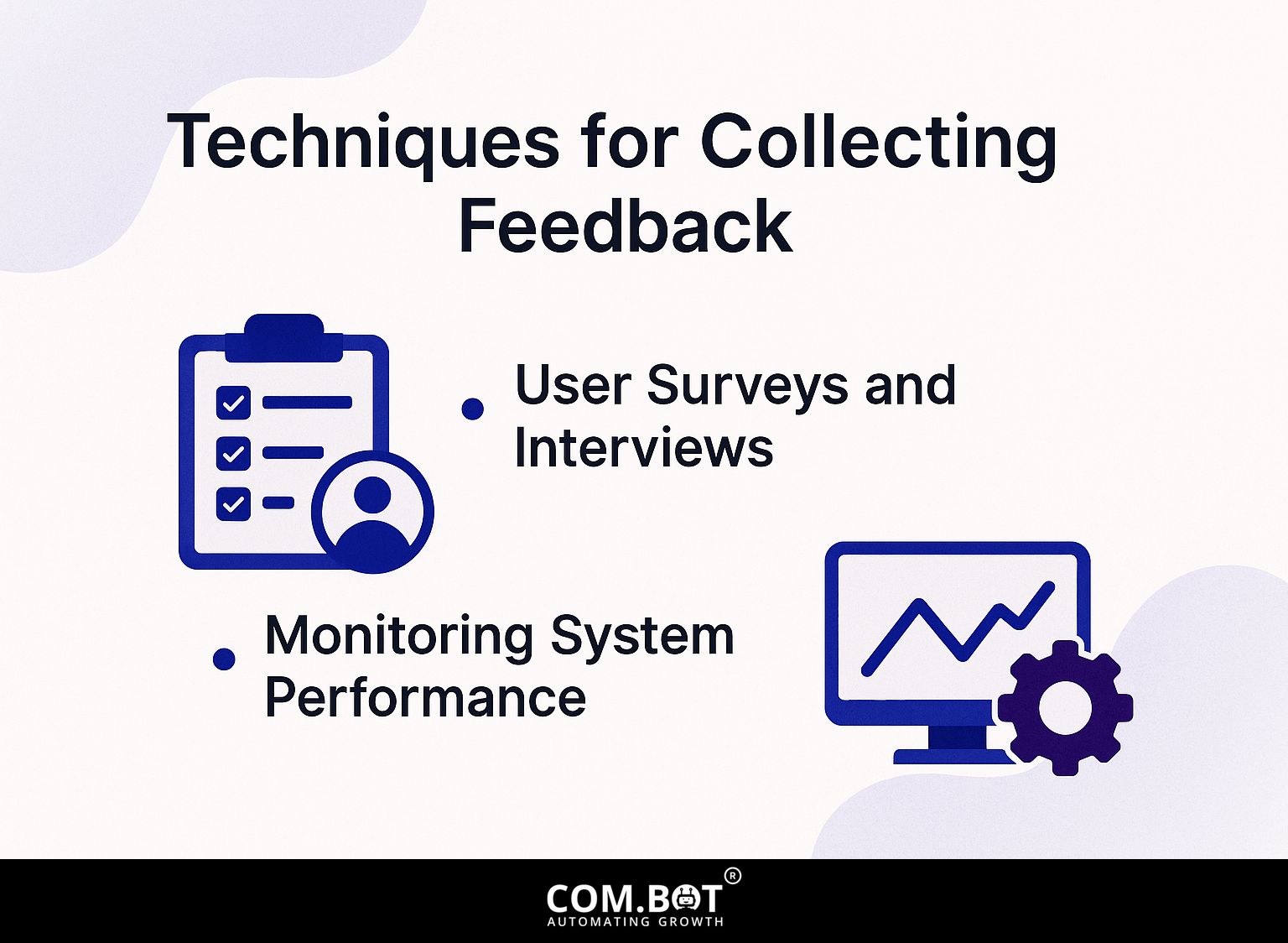
Effective ways to gather feedback are necessary to improve AI systems and user experience with useful information.
User Surveys and Interviews
User surveys and interviews are powerful tools for gathering qualitative feedback, with response rates averaging 20-30% for well-structured surveys.
To maximize engagement and quality responses, consider using platforms like SurveyMonkey or Google Forms to create user-friendly surveys. Begin by setting clear goals, like learning what users like or finding areas of discomfort.
Use open-ended questions to encourage detailed responses and limit questions to around 10 to avoid fatigue.
For interviews, choose tools like Zoom for virtual discussions, and prepare an informal script to guide the conversation.
Offering incentives like gift cards can greatly increase participation rates.
Monitoring System Performance
Monitoring system performance through analytics tools enables organizations to detect anomalies and adjust AI responses in real-time.
To improve how you monitor performance, begin by adding Google Analytics to check user actions and find areas that need work.
- Consider setting up goals to measure specific outcomes, such as conversion rates or bounce rates.
- Use data visualization tools like Tableau or Power BI to easily see your data trends.
- Review this information weekly to spot patterns and make informed adjustments.
This active method keeps your systems working well and growing to match what users want.
Improving AI Systems through Feedback
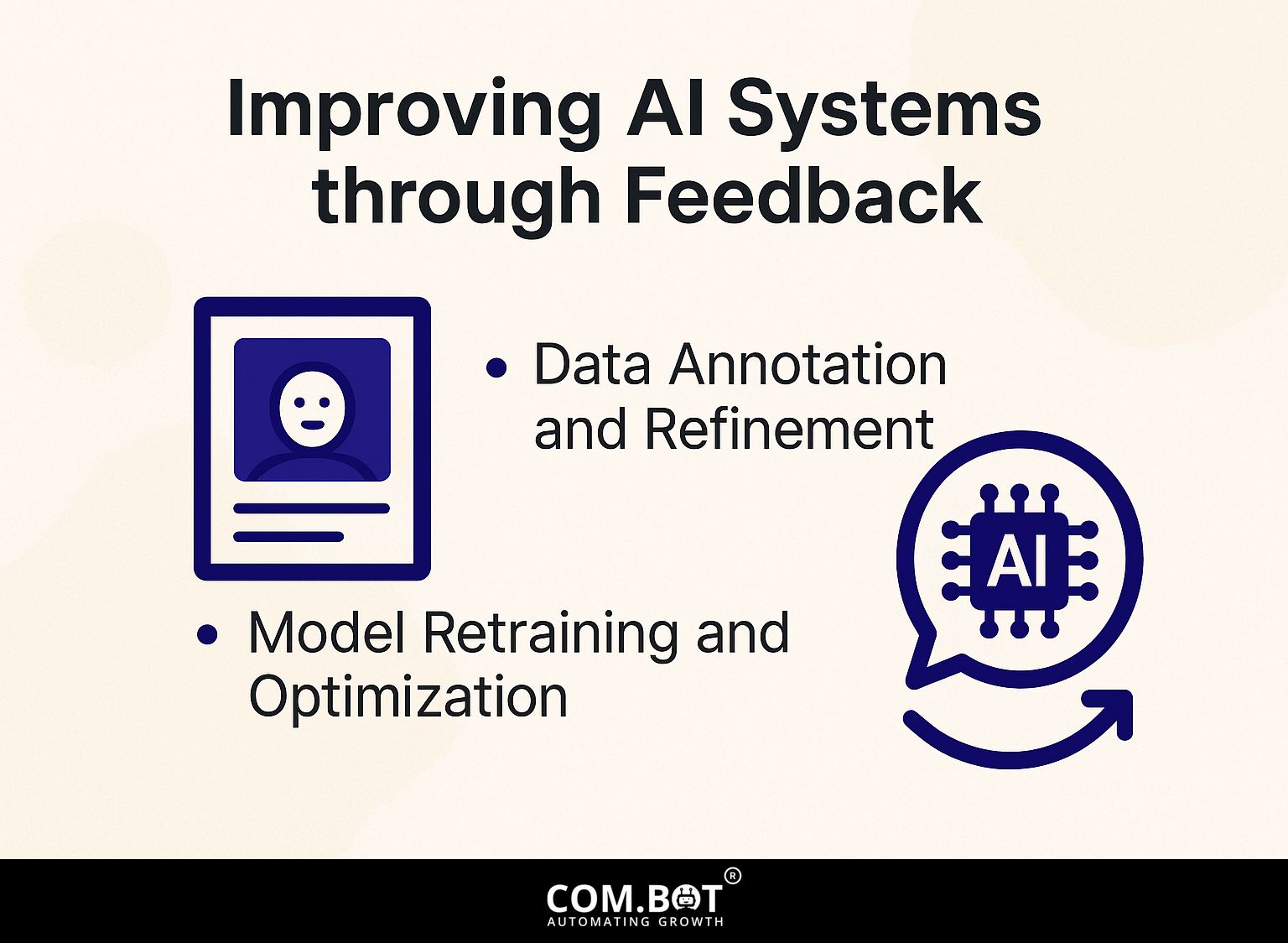
Feedback is used to find problems and improve AI models gradually.
Data Annotation and Refinement
Data annotation improves AI model accuracy by refining training data, with a 15% increase in performance reported from properly annotated datasets.
-
To improve data processing, begin by figuring out the exact details your dataset needs, like labeling images or sorting text.
-
Next, use tools like Label Studio to set up an annotation interface that fits your project needs. You can bring in and handle your data easily.
-
Think about making clear rules for labeling data so everyone in the team uses the same approach. Regularly check the marked examples to give comments and help improve.
By carefully improving your data, you can greatly improve how well your AI models work.
Model Retraining and Optimization
Updating models regularly with user feedback can increase AI accuracy by 20%, which is important for keeping up with how user behaviors change.
For successful retraining, schedule regular meetings every two weeks to evaluate the model’s performance and adjust it using data from user interactions.
Techniques include supervised learning, where labeled user interactions inform updates, and reinforcement learning, which adjusts the model based on real-time feedback.
Use tools like TensorFlow or PyTorch to make these processes easier.
Get users to give direct feedback through surveys or user testing sessions to keep the model in line with their changing needs and expectations.
Challenges in Implementing Feedback Loops
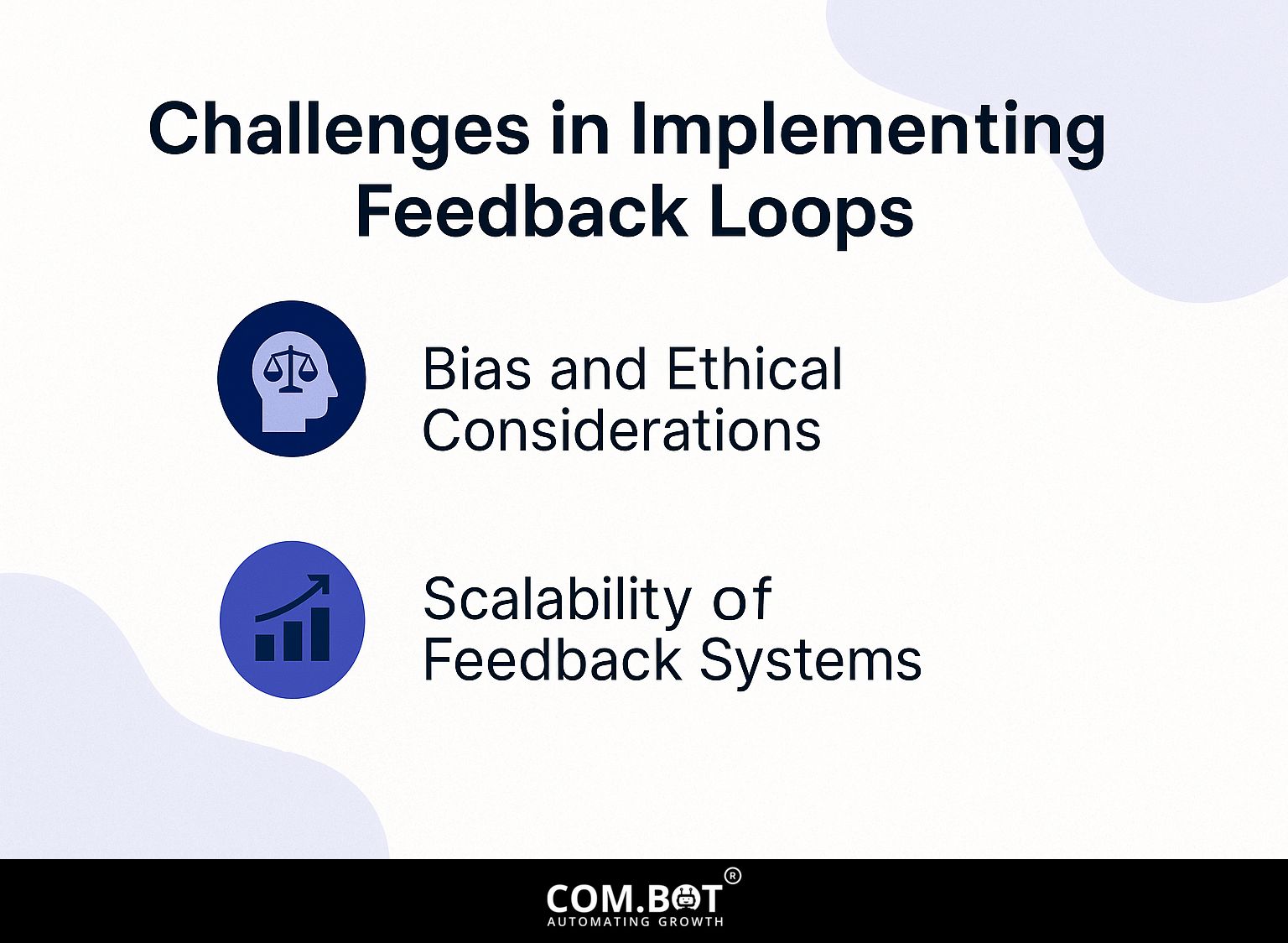
Setting up good feedback mechanisms in AI systems can be difficult, which may affect how well they work and how happy users are with them. To delve deeper into how feedback can enhance AI systems, consider exploring techniques for improving feedback loops.
Bias and Ethical Considerations
Bias in feedback mechanisms can lead to unfair AI outcomes, necessitating a focus on ethical considerations in data collection and model training.
To minimize bias, organizations should adopt diverse data sources, ensuring representation across various demographics. For instance, if training a facial recognition system, include images from multiple ethnic backgrounds.
Implementing continuous monitoring can identify bias. Tools like IBM’s AI Fairness 360 offer ways to evaluate how models perform for different groups.
Regular reviews and feedback meetings with stakeholders can make AI use more responsible. This includes getting opinions from the communities involved and allowing for continuous updates to the system.
Scalability of Feedback Systems
As AI systems grow, ensuring the scalability of feedback mechanisms becomes a critical factor for maintaining operational efficiency and system performance.
To address this challenge, consider implementing cloud-based tools like Google Cloud AI or Azure Machine Learning. These platforms allow for real-time data analysis and can change feedback loops automatically based on how users interact.
For instance, using Google’s AI Platform allows you to scale your feedback systems effectively, maintaining performance during peak usage. Integrating tools like Tableau for data visualization can help identify trends and patterns, ensuring your feedback mechanisms are both scalable and actionable.
Begin with a test project to confirm the method works before using it completely.
Future Directions for Feedback in AI
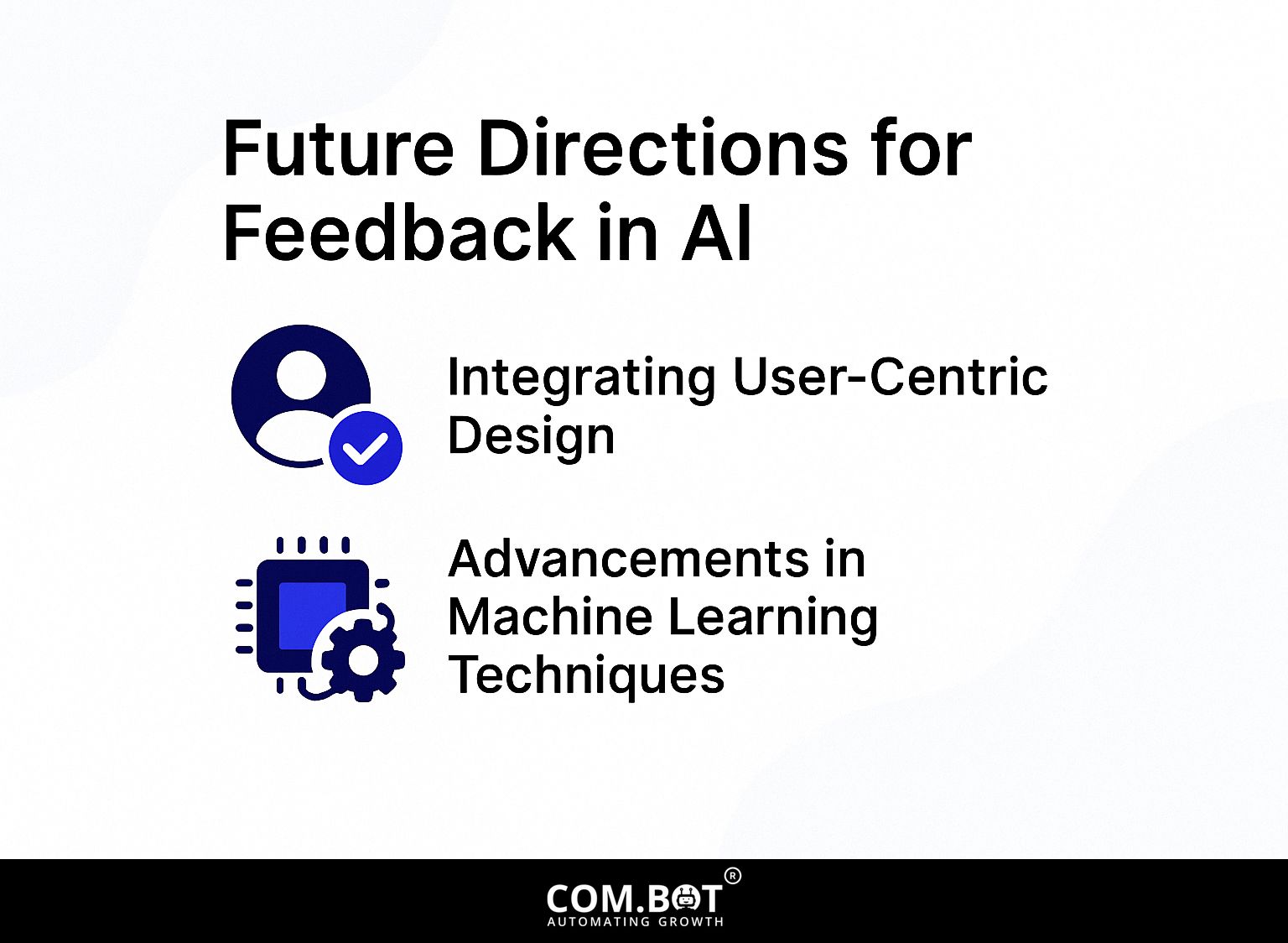
The next steps for feedback in AI systems will center on combining user-friendly design with advanced machine learning methods to improve flexibility and accuracy. For more insights into enhancing these systems, consider exploring the importance and improvement techniques for AI feedback.
Integrating User-Centric Design
Prioritizing user-centric design in AI systems can lead to higher user satisfaction and engagement, significantly improving the quality of feedback received.
Implementing user-centric design involves actively involving users in the development process. For instance, in healthcare, platforms like MyChart collect patient feedback to improve usability, helping users easily monitor their health information.
Amazon improves customer experience in e-commerce by giving personal recommendations based on user actions.
Tools like UserTesting can collect immediate feedback while people use the product, and surveys along with A/B testing can adjust designs based on what users prefer.
By using these strategies, organizations can build AI systems that connect well with users and work effectively.
Advancements in Machine Learning Techniques
Recent progress in machine learning, like deep learning and reinforcement learning, is changing how feedback is used in AI systems.
Deep learning algorithms improve feedback systems by analyzing large volumes of data to make better predictions.
For example, a recommendation system like Netflix uses deep learning to analyze viewer habits and improve suggestions.
Reinforcement learning enhances decision-making by learning from errors. For example, game-playing AIs like AlphaGo changed their strategies based on results from earlier actions.
These methods make user experience better by adjusting interactions and giving more accurate results.
Frequently Asked Questions
What is the importance of feedback for AI systems?
Feedback is important for AI systems because it helps them keep getting better and learn from their errors. It helps them make better decisions quickly and correctly.
How does feedback contribute to the improvement of AI systems?
Feedback gives AI systems important information, helping them find and fix mistakes in their algorithms. It also lets them adjust to new situations and get better at what they do as time goes on.
What are some common techniques used to gather feedback for AI systems?
Some common techniques include user surveys, interviews, user testing, and data analysis. These methods allow for both quantitative and qualitative feedback to be collected from users.
Why is it important to have a diverse range of feedback for AI systems?
Listening to feedback from a wide range of people helps AI systems better understand different viewpoints and make better decisions. It also helps to prevent biases and improve accuracy.
How can AI systems use feedback to address ethical concerns?
By gathering feedback from users, AI systems can identify potential ethical concerns and address them through algorithmic changes or updates. This makes sure the system is fair and moral when it makes decisions.
How can businesses use feedback to improve their AI systems?
Businesses can use feedback to identify areas of improvement for their AI systems, such as user experience, accuracy, and efficiency. This information can then be used to make necessary changes and updates to the system for better performance and customer satisfaction.

